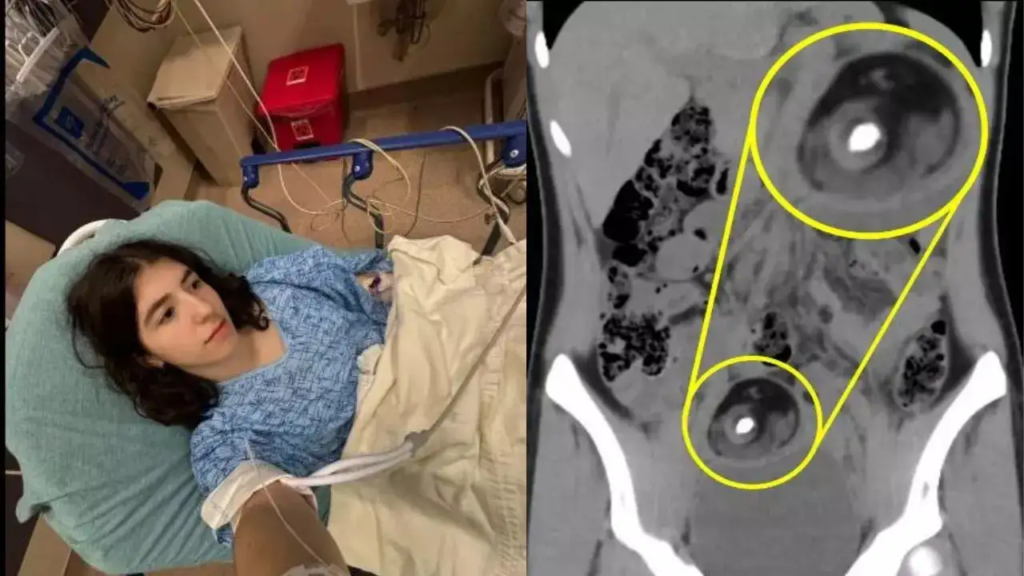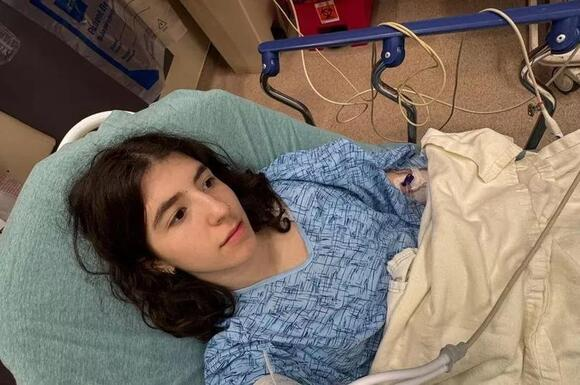A 17-year-old girl, Nesli Meir, experienced severe and persistent abdominal Pain Turned Out To Be Tennis Ball Size Tumour. What she initially dismissed as normal stomach aches turned out to be a rare and unusual medical condition.
A CT scan revealed that she had a large, benign teratoma tumour growing inside her, with bizarre characteristics like the presence of a tooth. The case has sparked curiosity and concern about teratomas, their formation, symptoms, and possible treatment options.
Stomach Pain Turned Out To Be Tennis Ball Size Tumour
Nesli Meir, a teenage girl, had been suffering from sharp and recurrent pain in her lower right abdomen. Like many teenagers, she assumed the pain was due to common stomach issues and ignored it for a while.
However, as time passed, the pain became unbearable, prompting her to seek medical attention. When she finally went to the hospital, doctors conducted a CT scan and made a shocking discovery. Nesli had a tennis-ball-sized tumour in her ovary, medically classified as a benign teratoma.
A teratoma is a type of germ cell tumour that originates in reproductive cells like eggs and sperm. These tumours can contain different types of tissues, including hair, bones, and even teeth.
In Nesli’s case, the tumour had developed a tooth, which was both fascinating and alarming. Additionally, another smaller tumour was also found in the same region, raising concerns about her reproductive health.
Read : 6-Year-Old Boy Dies After His Weight Doubled in 16 Months Due To Brain Tumor
Doctors informed Nesli that the tumour resulted from calcification, a process where excess calcium hardens tissue, leading to abnormal growths. They also mentioned that the tumour could contain fluid resembling an eyeball.
Read : 4,000-Year-Old Skull Reveals Ancient Egyptians Were Trying to Cure Cancer
This unusual aspect made the case even more extraordinary. The medical team advised that surgery was necessary to remove the tumour, and there was a possibility that she could lose her right ovary in the process.
The severity of her condition was evident as Nesli described the immense pain she was experiencing. Despite trying to ignore the pain, it lingered constantly, affecting her daily life. The rare nature of her case gained attention, shedding light on teratoma tumours and their unusual characteristics.
Understanding Teratoma Tumours: Causes and Symptoms
Teratomas are a rare type of tumour that originates from germ cells, which are the reproductive cells responsible for developing eggs and sperm.

Unlike most tumours that consist of uniform tissue, teratomas are unique because they can differentiate into multiple types of tissue. This means they can contain structures like hair, teeth, bones, and sometimes even more complex body parts like parts of the liver, lungs, or brain.
Medical experts classify teratomas into two main types:
- Mature Teratomas: These are usually benign and do not spread to other parts of the body. They are often removed surgically without major complications.
- Immature Teratomas: These are malignant and more aggressive, potentially spreading to other areas of the body and requiring extensive treatment such as chemotherapy.
While the exact cause of teratomas is still not completely understood, they are believed to form due to disruptions in the differentiation process of germ cells. During embryonic development, unspecialized cells transform into specific cells like blood cells, nerve cells, and muscle cells. However, in the case of teratomas, germ cells randomly develop into various tissue types, leading to bizarre formations like hair, teeth, or bone.
The symptoms of teratomas can vary significantly depending on their location. Some common symptoms include:
- Persistent pain in the affected area
- Swelling or a noticeable lump
- Abdominal or pelvic pain
- Bleeding or discomfort during menstruation
- Constipation or difficulty with bowel movements
- Weakness in the legs (if the tumour presses on nerves)
Teratomas are usually detected through imaging techniques like ultrasound, CT scans, or MRI. In some cases, blood tests measuring tumour markers such as BhCG (beta-human chorionic gonadotropin) or AFP (alpha-fetoprotein) may help in the diagnosis.
Treatment and Recovery: What Comes Next?
For Nesli, the next step was surgery to remove the teratoma and prevent further complications. Surgical removal is the primary treatment for most teratomas, especially if they are large or causing significant symptoms.
The procedure involves making an incision in the abdomen to carefully extract the tumour while preserving as much healthy ovarian tissue as possible.
In some cases, if the tumour is small and not causing major problems, doctors may adopt a wait-and-watch approach. However, given the size and nature of Nesli’s tumour, immediate surgery was the best course of action.
While most mature teratomas are benign, there is always a risk of recurrence. Doctors recommend regular follow-ups and imaging scans to monitor for any new growths. If a teratoma is malignant, additional treatments such as chemotherapy or radiation may be required.
Recovery after surgery depends on various factors, including the size of the tumour, the complexity of the operation, and the patient’s overall health. Most patients can resume normal activities within a few weeks.
However, the emotional impact of discovering such an unusual medical condition can be significant. Patients often require counseling or psychological support to cope with the shock and anxiety that comes with such a diagnosis.

For young women like Nesli, concerns about fertility are also important. Losing an ovary can affect reproductive health, but in most cases, the remaining ovary compensates for the lost function. Advances in medical science also offer fertility preservation options, such as egg freezing, for those worried about future pregnancies.
Nesli Meir’s case serves as a reminder of the importance of listening to our bodies and seeking medical attention when something feels wrong. What started as a simple stomach ache turned out to be a rare and shocking tumour, highlighting the unpredictable nature of medical conditions. Teratomas, though rare, can develop in anyone and require timely diagnosis and treatment.
Understanding teratomas, their symptoms, and their causes can help raise awareness about this unusual medical condition. While they are often benign, they can cause significant discomfort and require surgical intervention. The advancements in medical technology ensure that conditions like these can be treated effectively, helping patients like Nesli recover and lead normal lives.
For those experiencing persistent pain or unusual symptoms, it is crucial not to ignore them. Seeking timely medical help can make a significant difference in early detection and successful treatment. Nesli’s story is a testament to the unpredictable wonders of the human body and the importance of medical science in uncovering and treating rare conditions.
As she prepares for surgery, Nesli remains hopeful, knowing that modern medicine has the tools to help her regain her health and well-being. Her journey serves as both a cautionary tale and a source of inspiration for others facing similar health challenges.
let’s enjoy few years on earth with peace and happiness….✍🏼🙏

